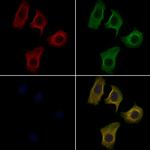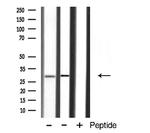Search Thermo Fisher Scientific
FIGURE: 1 / 2
APOA1BP Antibody (PA5-118846) in ICC/IF


Product Details
PA5-118846
Species Reactivity
Host/Isotype
Class
Type
Immunogen
Conjugate
Form
Concentration
Purification
Storage buffer
Contains
Storage conditions
Shipping conditions
RRID
Product Specific Information
Antibody detects endogenous levels of total AIBP.
Target Information
The product of this gene interacts with apolipoprotein A-I (apoA-I), the major apolipoprotein of high-density lipoproteins (HDLs). It is secreted into some bodily fluids, and its synthesis and secretion are stimulated in vitro by incubating cells with apoA-I. The human genome contains related pseudogenes.
For Research Use Only. Not for use in diagnostic procedures. Not for resale without express authorization.
References (0)
Bioinformatics
Protein Aliases: AI-BP; AI-BP {ECO:0000255|HAMAP-Rule:MF_03159}; apoA-I binding protein; apolipoprotein A-I binding protein; apolipoprotein A-I interacting protein; Apolipoprotein A-I-binding protein; apolipoprotein A-I-binding protein {ECO:0000255|HAMAP-Rule:MF_03159}; MGC119143; MGC119144; MGC119145; NAD(P)H-hydrate epimerase; NAD(P)H-hydrate epimerase {ECO:0000255|HAMAP-Rule:MF_03159}; NAD(P)HX epimerase; NAD(P)HX epimerase {ECO:0000255|HAMAP-Rule:MF_03159}; NAXE; YjeF N-terminal domain-containing protein 1; YjeF_N1
Gene Aliases: AA087124; AI-BP; AIBP; APOA1BP; Apoa1ip; ESTM37; NAXE; YJEFN1
UniProt ID: (Mouse) Q8K4Z3, (Human) Q8NCW5
Entrez Gene ID: (Rat) 295229, (Mouse) 246703, (Human) 128240

Performance Guarantee
If an Invitrogen™ antibody doesn't perform as described on our website or datasheet,we'll replace the product at no cost to you, or provide you with a credit for a future purchase.*
Learn more
We're here to help
Get expert recommendations for common problems or connect directly with an on staff expert for technical assistance related to applications, equipment and general product use.
Contact tech support
